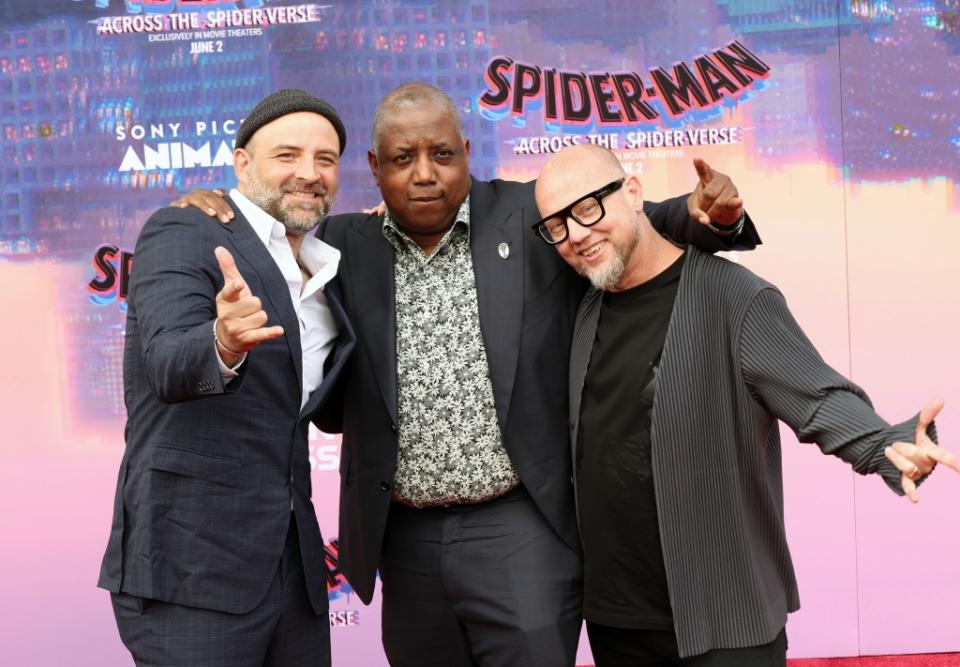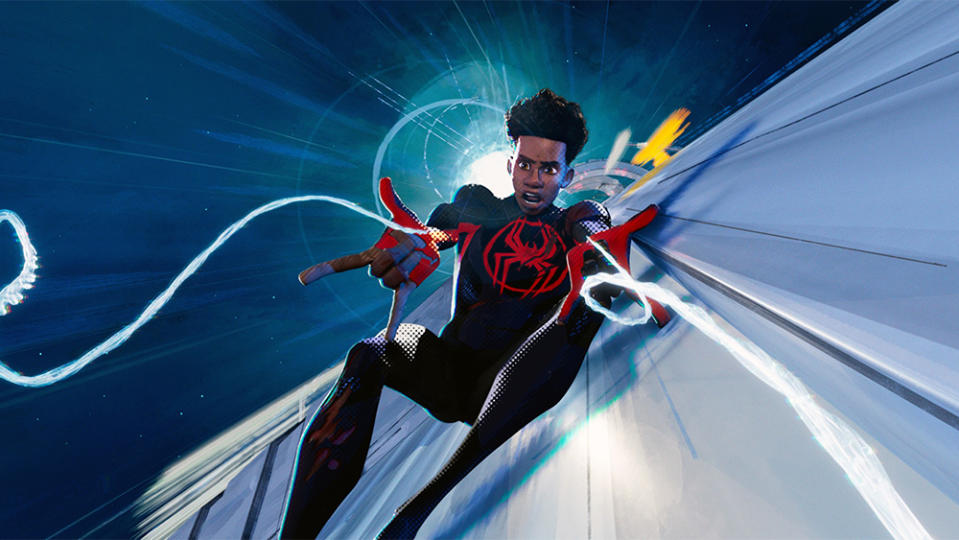Inside ‘Across the Spider-Verse’: Last Minute Live-Action Shoots, Major Rewrites and Setting Up the Final Film

SPOILER ALERT: This story discusses major plot developments and surprises throughout “Spider-Man: Across the Spider-Verse,” now playing in theaters.
For months, the directors of “Spider-Man: Across the Spider-Verse” had been working exhaustively on a critical sequence that launches the movie’s second act. For the first time in his life, the animated film’s hero — Miles Morales (Shameik Moore), a.k.a. the Spider-Man of Earth-1610 — enters a different dimension: Earth-50101, a.k.a. Mumbattan, a dazzling amalgamation of New York City and Mumbai. Within minutes, Miles and his BFF from 2018’s “Spider-Man: Into the Spider-Verse,” Gwen Stacy (Hailee Steinfeld), encounter that world’s Spider-Man, Pavitr Prabhakar (Karan Soni), an Indian teenager who received his powers not via spider bite, but through magic. The sequence launches them all through the vertiginously vertical metropolis, as they frantically try to stop the film’s villain, the Spot (Jason Schwartzman), from using Mumbattan’s supercollider to increase his dimension-hopping abilities.
More from Variety
'Spider-Man: Across The Spider-Verse' Swings to Top of U.K. Box Office
Inside Metro Boomin's Big Move Into Film and the 'Spider-Verse' (EXCLUSIVE)
How Sony's 'Spider-Verse' Franchise Struck Box Office Gold... Again
“We had worked on that sequence for a while, and we finally got it to a place where logically and from a staging perspective, it was doing all the things,” says Joaquim Dos Santos, who directed “Across the Spider-Verse” along with Kemp Powers and Justin K. Thompson. But as the directors watched the semi-finished sequence unfold with producers and screenwriters Christopher Miller and Phil Lord (who wrote the script with David Callaham), something wasn’t quite working.
“It was like, ‘Why is this just a wet blanket right now?’” Dos Santos recalls. “‘It gets really crazy here — but we’re not connected to the story.’”
Then the directors got an email from some Indian members of the animation team based at Sony Pictures Imageworks in Vancouver, who told them that Pavitr, the emotional anchor of the sequence, “doesn’t feel authentic,” as Powers recalls. “He doesn’t feel aspirational.”
Even though the sequence was, Powers says, “already quite far along in the production process,” the filmmaking team halted work on it.
“We very quickly assembled a writers room of Indian and Indian American writers,” Powers says, which included Soni (“Deadpool”) and comedian Hasan Minhaj. “We literally re-broke the entire sequence and reimagined the Pav character. And then Chris and Phil very quickly rewrote the entire script for that section so that Pav’s characterization completely changed.” Pavitr became joyous and unshakably optimistic, a character whose natural talent and charisma after mere months as a Spider-Man further exacerbates Miles’ anxiety about his own Spider-abilities.
“Of the new characters that are in the film, I think Pav is one that, collectively, we’re the most proud of,” Powers says, as Dos Santos and Thompson nod in agreement in separate Zoom windows. “It really spoke to the spirit of collaboration on this movie. You have to be open in this process to criticism and to good ideas from wherever they come. And that really speaks to the amount of problem solving that we had to go through to make sure that that character who’s supposed to represent a very specific part of the world felt authentic to people from that part of the world.”
The experience with Pavitr was just one of an elaborate — pun intended — web of creative decisions the three filmmakers had to make to transform “Across the Spider-Verse” into a crackling entertainment, a living work of art, an intimate portrait of one family and a sprawling superhero epic that transcends the very fabric of reality. The decision to allow Miles to travel, as the title exclaims, “Across the Spider-Verse” — rather than bring different Spider-People into Miles’ world — exponentially increased the narrative complexity of the film, requiring new visual languages for entire worlds rather than specific characters. It also had the filmmakers exploring how (and how much) to incorporate live-action into the film, and how to exploit the conceit of the multiverse to deepen Miles’ connection to his own heroism. And then they had to set up Miles’ journey for the conclusion of the trilogy, 2024’s “Beyond the Spider-Verse,” which is already well into production with all three directing.
But before Dos Santos, Powers and Thompson could discuss all of that with Variety, they had to settle a more basic question: What did each of them do as directors on the film?

“Everyone had to do everything.”
With three people each overseeing production on “Across the Spider-Verse,” one would easily expect them to divvy up responsibilities on the film, especially since for Thompson and Dos Santos, this is their feature directing debut. But it wasn’t quite that cut-and-dried.
“I think we all shared the responsibilities, if you want to call them that,” Thompson says. “’Responsibilities’ ‘is such an impressive word to use for what we do.”
As Powers puts it, “Everyone had to do everything.”
Still, each of the directors came to the film with specific areas of expertise that did inform what they spent much of their time focusing on during production. Thompson had served as the production designer for “Into the Spider-Verse” as well as Sony Pictures Animation’s “Cloudy With a Chance of Meatballs” and its sequel. So he spent a great deal of time focusing on building out the film’s heterodox visual approach, allowing each new universe and/or Spider-Person from a new universe to be presented with a unique subset of techniques and styles.
“I was working on the effects in the art direction, working with the animators, all that kind of stuff, making sure that film was actually coming together in its final form,” Thompson said. “That’s where I spent a lot of my time near the end of the film.”
Powers’ background is in writing — he was nominated for an Oscar for his screenplay for 2020’s “One Night in Miami,” adapted from his stage play of the same title, and he co-directed Pixar’s 2020 Oscar-winning feature “Soul” with Pete Docter. So he focused on the film’s story, and how it was performed and assembled. “I definitely did a lot of the work directly with the actors, directing their voice recording sessions, often with Phil or Chris,” Powers says. “I spent a lot of time in edit, cutting stuff together with Mike Andrews, our editor, and Phil and Chris. And of course, there’s no way I’m not going to be working on that script.”
Joaquim Dos Santos, who worked as a director and executive producer on Nickelodeon’s “The Legend of Korra” and “Avatar: The Last Airbender,” started as a storyboard artist, a position relatively unique to animation that’s instrumental to sorting out the specifics of how a film will be telling a story visually. “So a lot of what I did was sort of figuring out what the action was going to be, what the dramatic moments were going to be, lensing those as early as possible through the storyboarding process,” Dos Santos says. With such an intricate — and frequently changing — narrative, Dos Santos oversaw putting together rough assemblages so the filmmaking team could physically see how the “bigger, crazier set pieces” were coming together.
Even within these areas of specialization, however, the filmmakers were rarely separated from each other for very long. “We’d all come back together at the end of every day and compare notes,” Thompson says. “Or in the middle of the day or in the very early hours of the morning, whatever it needed to be. It was like a constant expanding and contracting.”
Dos Santos credits Thompson for being the person who most frequently would call the rest of the team together to focus on whatever needed the most attention at that moment, to be sure everyone was on the same page. “He’d be like, ‘Everybody look at the screen at the same time.’ We’d go, ‘Yeah, that looks cool. Good. Everybody go back to their corners now.’”

“Don’t give in to all these people making these rules.”
In “Across the Spider-Verse,” Miles learns that the dimension-hopping shenanigans in “Into the Spider-Verse” — starting with the radioactive spider from Earth-42 that bit him in Earth-1610 — have caused the multiverse to grow dangerously unstable. To protect it, the Spider-Man from Earth-298 — Miguel O’Hara (Oscar Isaac), a.k.a. Spider-Man 2099, who was introduced in the post-credits scene in “Into the Spider-Verse” — gathers an army from across the multiverse of thousands of Spider-People, known as the Spider Society.
That provided the filmmakers with an overwhelming number of new Spider-People to choose from to fight alongside (and, eventually, against) Miles. So to focus their thinking, “We just thought about Miles’s journey,” Thompson says. “What a 15-year-old boy, who is leaving the safety of his mother’s protection for the first time, needs. He’s going to face all the kind of challenges that teenagers face when they start making their own choices. We wanted to put Spider-People in front of him that would encourage him to be true to himself.”
The filmmakers ultimately honed in on Miguel, an authority figure standing in the way of Miles’ progress; Pavitr, a budding Spider-Person who seems free of the angst and indecision haunting Miles; and Jessica Drew, a.k.a. Spider-Woman (Issa Rae), who serves the same mentor role for Gwen that Peter B. Parker (Jake Johnson) served for Miles in “Into the Spider-Verse.”
The lynchpin character for Miles, however, turned out to be Hobie Brown, a.k.a. Spider-Punk, a British Spider-Person who lives in a universe dominated by a totalitarian regime that causes Hobie to rebel in the style of a 1970s punk rocker. His anti-establishment philosophy served as a crucial counterweight to Miles’s infatuation with the Spider Society, an organized bureaucracy that fulfills Miles’s hunger to connect with more people who understand what it means to be Spider-Man.
“The Spider Society was this huge thing that Miles had built up in his head,” Thompson says. “Other than just being cool and awesome, Punk was there to try to remind Miles: Don’t put all your value and all your faith in all of this artifice here. Don’t give in to all these people making these rules. Even visually, he’s an anarchist — he doesn’t stay situated in one style.”
No kidding: Hobie looks like an ever-changing, two-dimensional collage, in striking contrast to everything and everyone around him — at certain points, some parts of his body move at a different frame-rate than his clothing. “The inspiration came from old punk rock posters of the ’70s and ’80s,” Dos Santos says. “You take a picture, you Xerox it, draw over it, Xerox that, staple that to a thing, pull it down, Xerox that. That was the vibe there. It’s a hard thing to pull off, but if you were to try to gussy it up, you lose the spirit of who that character is. The character should not work.”

“We had even bigger ambitions.”
From the beginning, the filmmakers knew that “Across the Spider-Verse” would integrate the various live-action iterations of the character. Miles learns that the multiverse is held together by “canon events” — synchronistic moments common for all Spider-People, almost always rooted in the tragic and traumatic death of someone close to them. In the film, Miles witnesses some of those scenes from movies like 2002’s “Spider-Man” with Tobey Maguire and 2012’s “The Amazing Spider-Man” with Andrew Garfield — included with the help of producers Amy Pascal and Avi Arad, the main executives responsible for those films.
Originally, however, “Across the Spider-Verse” was going to include much more than clips from old films.
“We had even bigger ambitions,” Thompson says.
Adds Powers, “There were times when we had huge live-action sequences in the film, and it just turned into a bad joke,” he says. “Even we didn’t like it anymore. And we just said, ‘OK, enough, let’s make sure that it’s something precise that gets the most bang for the buck, and speaks to the story.’”
They decline to elaborate on what these sequences entailed, only to say that they existed as storyboards and animatics with cut-out versions of the live-action characters and crew members dubbing in their voices.
“They had the look of like a ‘South Park’ character,” Powers says with a chuckle.
Thompson jumps in: “We should do that as a character.”
Other than the clips, there are just two live-action moments in “Across the Spider-Verse”: Donald Glover appears as the human version of Miles’ uncle Aaron, whom the actor first portrayed in 2017’s “Spider-Man: Homecoming.” And Peggy Lu appears as the bodega clerk Mrs. Chen from the “Venom” movies with Tom Hardy. The latter was built from unused B-roll footage, say the filmmakers, part of a sequence in which the Spot learns of his universe-hopping abilities that was added relatively late in the production.
Thanks in part to schedule, Glover’s sequence, however, made it into the movie even later.
“It was shot at a studio in New York,” Powers says. “Chris Miller flew to be there in person, and Phil Lord and I were on the video feed giving direction. We got it in at the 11th hour. As a matter of fact, even in audience preview screenings, it was a little cardboard cutout of Donald Glover.”
Adds Dos Santos, “We knew it was still going to land, though, because the idea of it still got people geeked. That’s when you know you have something.”

“Anything is possible.”
Because “Across the Spider-Verse” was always meant to end with a cliffhanger, the filmmakers knew they wanted to “introduce a new problem that’s going to be a major, not-simple-to-solve problem in the third film,” says Powers. So they decided to place Miles inside Earth-42, i.e. the universe that is missing its Spider-Person because the radioactive spider from that reality was zapped into Miles’s world instead. There, Miles discovers that instead of his Uncle Aaron dying, his own father died, and without a Spider-Person, the Miles Morales of this reality has turned to a life of crime.
“It was really important to have this thing where Miles wants to save his dad, but then he’s faced with this Pottersville version of a world that was created because of this thing that happened to him,” Powers says. “It’s not going to be as simple as him wanting to just escape this world. He’s going to try to do right by people who he feels he’s done wrong by, and that just felt more potentially emotional and unpredictable as we go into the third film. It complicates his mission in a way that we hope people find unexpected and also thrilling.”
The twist allows the filmmakers to bring the story back to Miles in the most personal terms possible. “The multiverse provides us with these sort of sliding doors,” says Dos Santos. “It allows us to ask these questions like the head games you play with yourself: ‘If I had done this, instead of that, what happens? How does my life turn out?’ You get to see those things play out on screen.”
Sony has dated “Beyond the Spider-Verse” to open on March 29, 2024 — less than a year away — but the directors have no idea whether the film will actually make that release date. Instead, they’re happy to bask in the stunning accomplishment of “Across the Spider-Verse.”
“We’re all excited to at least get a breather for now,” Thompson says.
Adds Dos Santos, “‘Beyond’ doesn’t happen if everybody didn’t believe to make this film as good as it could possibly be.”
How the end of “Across” is going to play out in “Beyond” — not to mention whether more new Spider-People will appear, and if more live-action elements will be used — are all question the directors are very happy not to answer.
“To quote Chris Miller: ‘Anything is possible’ is the best way we can answer,” Powers says. “We’re just so relieved to have this story done in a way that we’re proud of.”
Best of Variety
Sign up for Variety’s Newsletter. For the latest news, follow us on Facebook, Twitter, and Instagram.

 Yahoo Movies
Yahoo Movies 
